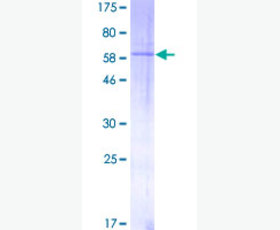Recombinant Mouse TIGIT/VSIG9/VSTM3
| Product name: | Recombinant Mouse TIGIT/VSIG9/VSTM3 |
| Source: | Human Cells |
| Purity: | Greater than 95% as determined by reducing SDS-PAGE. |
| Buffer Formulation: | Lyophilized from a 0.2 μm filtered solution of PBS, pH7.4. |
| Applications: | Applications:SDS-PAGE; WB; ELISA; IP. |
| Storage: | Avoid repeated freeze/thaw cycles. Store at 2-8 oC for one month. Aliquot and store at -80 oC for 12 months. |
| UOM: | 100ug/50ug/200ug/1mg/1g |
| Source | Human Cells |
| Description | Recombinant Mouse TIGIT is produced by our Mammalian expression system and the target gene encoding Gly26-Phe135 is expressed with a 6His tag at the C-terminus. |
| Names | T-cell immunoreceptor with Ig and ITIM domains,TIGIT,V-set and transmembrane domain-containing protein 3, VSTM3, REF: C1127 |
| Accession # | P86176 |
| Formulation | Lyophilized from a 0.2 μm filtered solution of PBS, pH7.4. |
| Shipping |
The product is shipped at ambient temperature. |
| Reconstitution |
Always centrifuge tubes before opening. Do not mix by vortex or pipetting. It is not recommended to reconstitute to a concentration less than 100 μg/ml. Dissolve the lyophilized protein in ddH2O. Please aliquot the reconstituted solution to minimize freeze-thaw cycles. |
| Storage |
Lyophilized protein should be stored at < -20°C, though stable at room temperature for 3 weeks. Reconstituted protein solution can be stored at 4-7°C for 2-7 days. Aliquots of reconstituted samples are stable at < -20°C for 3 months. |
| Purity |
Greater than 95% as determined by reducing SDS-PAGE. |
| Endotoxin | Less than 0.1 ng/µg (1 IEU/µg) as determined by LAL test. |
| Amino Acid Sequence |
GTIDTKRNISAEEGGSVILQCHFSSDTAEVTQVDWKQQDQLLAIYSVDLGWHVASVFSDRVVPGP SLGLTFQSLTMNDTGEYFCTYHTYPGGIYKGRIFLKVQESSVAQFGGGGSHHHHHH
|
| Background | T cell immunoreceptor with Ig and ITIM domains (TIGIT), also called WUCAM, VSIG9 and Vstm3, is a member of the CD28 family within the Ig superfamily of proteins. TIGIT contains an immunoglobulin variable domain, a transmembrane domain and an immunoreceptor tyrosine-based inhibitory motif (ITIM), and is expressed on regulatory, memory, activated T cells and NK cells. TIGIT binds to CD155(PVR) that appear on dendritic cells (DC), macrophages and endothelium with high affinity, and CD112(PVRL2) with lower affinity, but not CD113 (PVRL3). TIGIT-Fc fusion protein could interact with PVR on DC and enhance the secretion of IL-10, but inhibit the macrophage activation. Mice lacking TIGIT show increased T cell responses and susceptibility to autoimmune challenges, while knockdown of TIGIT with siRNA in human memory T cells did not affect T cell responses. |














